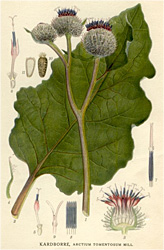
The 4 Herbs in René Caisse’s Formula
René Caisse’s formula that was assigned to The Resperin Corporation only contained 4 herbs, not 5, 6,or 7, as many would lead you to believe. Any product purporting to be her formula with more than these 4 herbs is misleading you and anyone telling you that they have taken her formula and improved upon it by adding more herbs to it is doing the same as they don’t have her original ( and only ) formula. The quality of the ingredients as well as the ratio of the herbs is obviously of prime importance in how the product functions, it’s as simple as that.
Burdock Root
.jpg) |
.jpg) |
 |
|||||
| 14 October 2006 by Michael Becker (License: GFDL 1.2) |
19 July 2005 by Pethan (License: GFDL 1.2) |
Illustration from Bilder ur Nordens Flora (Public Domain) |
|||||
The taproot of young burdock plants is a root vegetable that can be harvested and eaten. Slender burdock roots can grow to be about 1 metre long and 2 cm across. Burdock root is very crisp and has a sweet, mild, and pungent flavour. Immature burdock flower stalks are harvested in late spring before the flowers appear; the taste of the flower stalks resembles that of artichoke (to which the burdock is related).
Burdock is internationally recognized for its use in popular macrobiotic diets, which advocate its consumption.
The seeds of Greater Burdock (Arctium lappa) are used in traditional Chinese medicine.
Burdock Root: Medicinal Uses
The root of the burdock has been harvested for centuries for medicinal use, and is celebrated for having numerous medicinal uses:
- Burdock root provides inulin, a helpful sugar for diabetics.
- Burdock is classified as an alterative (a treatment or medication that restores health).
- Burdock is classified as a diuretic (a substance that tends to increase the discharge of urine, used in the treatment of high blood pressure, edema, and other medical conditions).
- Burdock is classified as a diaphoretic (a substance that induces perspiration).
- Burdock is believed to be a galactagogue (a substance that increases lactation).
- Burdock root is known as one of the finest herbal blood purifiers, helping the kidneys to filter out impurities from the blood and remove toxins from the system.
- Burdock root has also been reported to destroy bacteria and fungus cultures.
- Burdock root oil extract is a popular scalp treatment used to improve hair strength, shine and body, reverse scalp conditions such as dandruff, and combat hair loss.
- Burdock has been used as a topical remedy for skin problems such as acne, eczema, rosacea and psoriasis.
Burdock Root: Nutritional Information
Burdock contains a variety of important vitamins, minerals, and other elements:
- Vitamin B Complex
- Vitamin E
- Calcium
- Chromium
- Cobalt
- Iron
- Magnesium
- Phosphorus
- Potassium
- Silicon
- Sodium
- Zinc
- Phytosterols
- Essential Fatty Acids (including rare long-chain Essential Fatty Acids)
- Amino Acids
- Gobo Dietary Fibre (GDF, 6g per 100g)
Burdock: Taxonomy
| Kingdom: | Plantae |
|
| Division: | Magnoliophyta |
|
| Class: | Magnoliopsida |
|
| Order: | Asterales |
|
| Family: | Asteraceae |
|
| Genus: | Arctium |
|
| Species: | Arctium lappa: Greater Burdock, Gobo Arctium minus: Lesser Burdock, Burweed, Louse-bur, Button-bur Arctium minus nemorosum (Arctium vulgare): Woodland Burdock, Wood Burdock Arctium pubens: Common Burdock Arctium tomentosum: Downy Burdock, Woolly Burdock |
|
Sheep Sorrel
Sheep Sorrel has been a folk remedy for cancer for centuries in Asia, Europe, and North America. It is an astringent and diuretic. It contains Vitamins A, B complex, C, D, K, and E, as well as calcium, copper, iodine, iron, manganese, magnesium, silicon, sulphur, and zinc. Sheep Sorrel also contains beta-carotene and chlorophyll, and citric, malic, oxalic, tannic and tartaric acids, and is rich in potassium oxalate.
Slippery Elm Bark
The healing properties of the Slippery Elm come from the inner bark of the tree. The bark is very mucilaginous and is healing and soothing to mucous membranes. It contains gallic acid, phenols, starches, sugars, Vitamins A, B complex, C, K, and P, as well as calcium, chromium, iron, magnesium, phosphorus, selenium, silicon, sodium, and zinc. According to many herbalists, its benefits include soothing and strengthening the organs, tissues, and mucous membranes, especially the lungs, stomach, and bowels. It is known to be an antibiotic with anti-microbial effects and herbalists believe it assists in the removal of toxins from the body and is a revitalizer.
Rhubarb Root
The Rhubarb Root exerts a gentle laxative action by stimulating the secretion of bile into the intestines and it stimulates the gall duct to expel toxic waste. In addition, the liver is cleansed and the system is flushed. Rhubarb contains vitamins A, B complex, C, and P, as well as calcium, chlorine, copper, iodine, iron, magnesium, manganese, phosphorus, potassium, silicon, sodium, sulphur, and zinc. It is also known to be an astringent.
Resperin™ Canada Limited is the legal successor to the Resperin Corporation and is
the only company that can document receipt of Nurse René Caisse's original formulation.